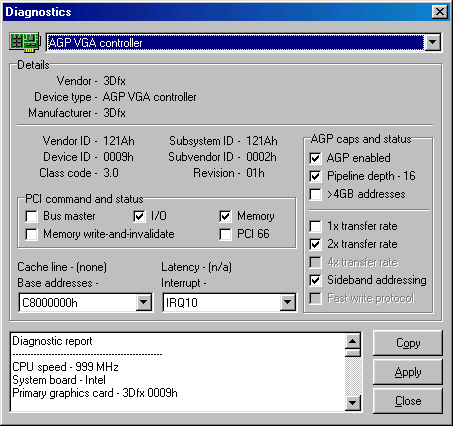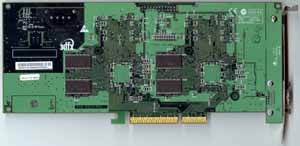The Card
The only VSA-100 based product currently available is the Voodoo5 5500 AGP, featuring two VSA-100 chips and a total of 64MB of SDRAM. The core and memory are both clocked at 166MHz. Because the two chips are working together in SLI mode, the 64MB of memory is split evenly between the two, and since they are essentially independent of one another, the textures in any scene must be duplicated in each set of 32MB of SDRAM. This means that if you have a scene with 10MB of textures, it occupies a total of 20MB of memory out of the 64MB on board since each chip requires those 10MB of textures to be available to it locally. Frame buffer memory is not duplicated between both banks, however, so the Voodoo5 effectively has more than 32MB of memory to work with but less than 64MB. The exact amount varies the resolution and color depth in use.
Each chip can render two single textured pixels per clock or one dual textured pixel per clock. This gives a single VSA-100 chip a fill rate of 333 megapixels per second when dealing with a single textured game, or 166 megapixels per second when running a dual textured game. For the Voodoo5 5500 AGP, this results in a fill rate of 667 megapixels per second for a single textured game or 333 megapixels per second for a dual textured game. Seemingly ages ago, when single textured games were the only things available, this sort of a fill rate made the most sense but as most of today’s games are dual textured, this sort of flexibility is not as useful as it once was. In fact, we once again see the roll reversal of 3dfx and NVIDIA - 3dfx always had the cards with the texel fill rate double the pixel fill rate, while NVIDIA always kept them equal. With the launch of the VSA-100 and the GeForce 2 GTS, those rolls are now reversed.
Each chip has its own 128-bit pathway to its 32MB of SDRAM, meaning that each chip has the bandwidth of an SDR GeForce 256. When put together, the card theoretically has about 5.3GB/s of available memory bandwidth, exactly as much bandwidth as a GeForce 2 GTS. While some of that bandwidth is wasted during texture upload, there is no real waste when rendering since each chip will only access the textures it needs.
So while 3dfx falls considerably behind in terms of raw (theoretical) fillrate, 3dfx still has a fighting chance as the NVIDIA cards are severely limited by memory bandwidth. Coincidentally, the Voodoo5 has the same memory bandwidth of the GeForce 2 GTS, 5.3GB/s, although they go about achieving it in different ways. Both manufacturers use a 128-bit data path running at 166 MHz to memory. This would result in 2.66GB/s of memory bandwidth, but both companies double this - 3dfx by using two independent paths to memory on two separate chips to transfer twice as much data at once, while NVIDIA uses DDR memory to transfer data twice per clock.
If NVIDIA is limited by this 5.3GB/s of bandwidth, it stands to reason that 3dfx could be limited similarly, and if the bottleneck is the same on both cards, it's possible the performance would be the same. Of course, all this theoretical talk is worthless if the results aren't borne out in the real world. We'll take a look at the real world performance in just a bit.
Our evaluation board featured eight 8MB 6ns SDRAM chips manufactured by Toshiba. The 6ns rating means that these chips should be able to work at 166MHz (which is what they’re clocked at) and not much higher. However, SDRAM chips are generally rated pretty liberally, meaning that a chip rated at 166MHz might be able to hit 183MHz. We'll take a more detailed look at overclocking in a moment as well.
Each VSA-100 chip is covered by a high quality AAVID heatsink and fan. Attached with a bit too much heatsink glue, the cooling on the Voodoo5 5500 is still quite good. To ensure that the dual VSA-100 chips get enough power, it draws its power from the +5V power rail of your power supply courtesy of the 4-pin power connector present on the board. The reason for the board’s incredible length is because all the components required to regulate the power supplied to the board must be present, instead of relying on the AGP slot to provide the power and the motherboard to regulate the power supplied.
Despite claimed support for AGP 4x in the VSA-100 chip, our board apparently does not support it. As we've shown in the past, AGP 4x offers virtually no performance advantage over AGP 2x, so it's not really a big deal, but still worth noting.

The beauty of the Voodoo5 5500 AGP as an evaluation sample is that, by disabling one of the chips, we essentially have a 32MB Voodoo4 4500 AGP card that we can also use to illustrate the performance we can expect out of that solution. As mentioned previously the Voodoo4 is not yet as available thanks to a component shortage.
|
Video
Card Specification Comparison
|
||||
|
3dfx
Voodoo5 5500
|
NVIDIA
GeForce2 GTS |
NVIDIA
GeForce2 MX |
NVIDIA
GeForce 256 |
|
| Core |
Napalm
(VSA-100)
|
NV15
|
NV11
|
NV10
|
|
Core Clock |
166MHz
|
200MHz
|
175MHz
|
120MHz
|
| Number of Chips |
2
|
1
|
1
|
1
|
| Rendering Pipelines |
2
|
4
|
2
|
4
|
| Texels/Clock/Pipeline |
1
|
2
|
2
|
1
|
| Fill Rate (Texels/Second) |
667
Million
|
1600
Million
|
700
Million
|
480
Million
|
| Memory Bus |
2
x 128-bit SDR
|
128-bit
DDR
|
128-bit
SDR
or 64-bit SDR/DDR |
128-bit
SDR/DDR
|
| Memory Clock |
166MHz
SDR
|
333MHz
DDR
|
166MHz
SDR
|
166
MHz SDR
300MHz DDR |
| Memory Bandwidth |
5.3
GB/s
|
5.3
GB/s
|
2.7
GB/s
|
2.7GB/s
(SDR)
4.8GB/s (DDR) |
| Manufacturing Process |
0.25-micron
(Enhanced) |
0.18-micron
|
0.22-micron
|
|












1 Comments
View All Comments